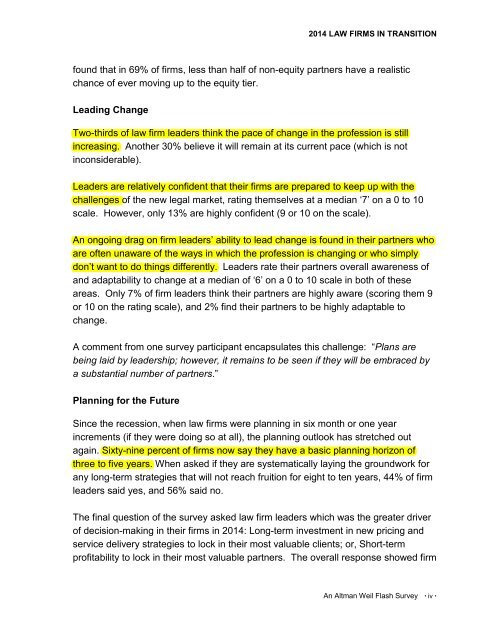MPF WHITE PAPER - AW 2014 Law Firms in Transition - 10-21-14
MPF WHITE PAPER - AW 2014 Law Firms in Transition - 10-21-14
MPF WHITE PAPER - AW 2014 Law Firms in Transition - 10-21-14
Create successful ePaper yourself
Turn your PDF publications into a flip-book with our unique Google optimized e-Paper software.
<strong>20<strong>14</strong></strong> L<strong>AW</strong> FIRMS IN TRANSITIONfound that <strong>in</strong> 69% of firms, less than half of non-equity partners have a realisticchance of ever mov<strong>in</strong>g up to the equity tier.Lead<strong>in</strong>g ChangeTwo-thirds of law firm leaders th<strong>in</strong>k the pace of change <strong>in</strong> the profession is still<strong>in</strong>creas<strong>in</strong>g. Another 30% believe it will rema<strong>in</strong> at its current pace (which is not<strong>in</strong>considerable).Leaders are relatively confident that their firms are prepared to keep up with thechallenges of the new legal market, rat<strong>in</strong>g themselves at a median ‘7’ on a 0 to <strong>10</strong>scale. However, only 13% are highly confident (9 or <strong>10</strong> on the scale).An ongo<strong>in</strong>g drag on firm leaders’ ability to lead change is found <strong>in</strong> their partners whoare often unaware of the ways <strong>in</strong> which the profession is chang<strong>in</strong>g or who simplydon’t want to do th<strong>in</strong>gs differently. Leaders rate their partners overall awareness ofand adaptability to change at a median of ‘6’ on a 0 to <strong>10</strong> scale <strong>in</strong> both of theseareas. Only 7% of firm leaders th<strong>in</strong>k their partners are highly aware (scor<strong>in</strong>g them 9or <strong>10</strong> on the rat<strong>in</strong>g scale), and 2% f<strong>in</strong>d their partners to be highly adaptable tochange.A comment from one survey participant encapsulates this challenge: “Plans arebe<strong>in</strong>g laid by leadership; however, it rema<strong>in</strong>s to be seen if they will be embraced bya substantial number of partners.”Plann<strong>in</strong>g for the FutureS<strong>in</strong>ce the recession, when law firms were plann<strong>in</strong>g <strong>in</strong> six month or one year<strong>in</strong>crements (if they were do<strong>in</strong>g so at all), the plann<strong>in</strong>g outlook has stretched outaga<strong>in</strong>. Sixty-n<strong>in</strong>e percent of firms now say they have a basic plann<strong>in</strong>g horizon ofthree to five years. When asked if they are systematically lay<strong>in</strong>g the groundwork forany long-term strategies that will not reach fruition for eight to ten years, 44% of firmleaders said yes, and 56% said no.The f<strong>in</strong>al question of the survey asked law firm leaders which was the greater driverof decision-mak<strong>in</strong>g <strong>in</strong> their firms <strong>in</strong> <strong>20<strong>14</strong></strong>: Long-term <strong>in</strong>vestment <strong>in</strong> new pric<strong>in</strong>g andservice delivery strategies to lock <strong>in</strong> their most valuable clients; or, Short-termprofitability to lock <strong>in</strong> their most valuable partners. The overall response showed firmAn Altman Weil Flash Survey iv



